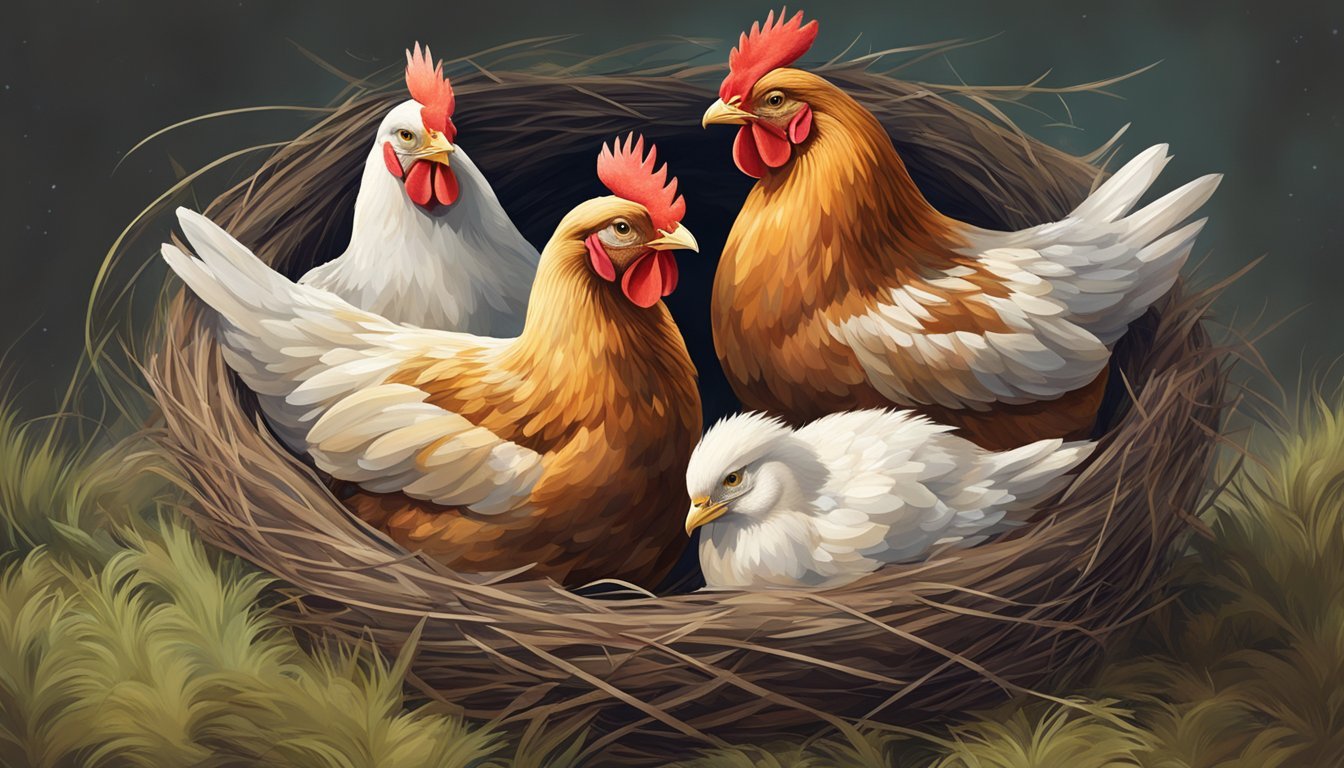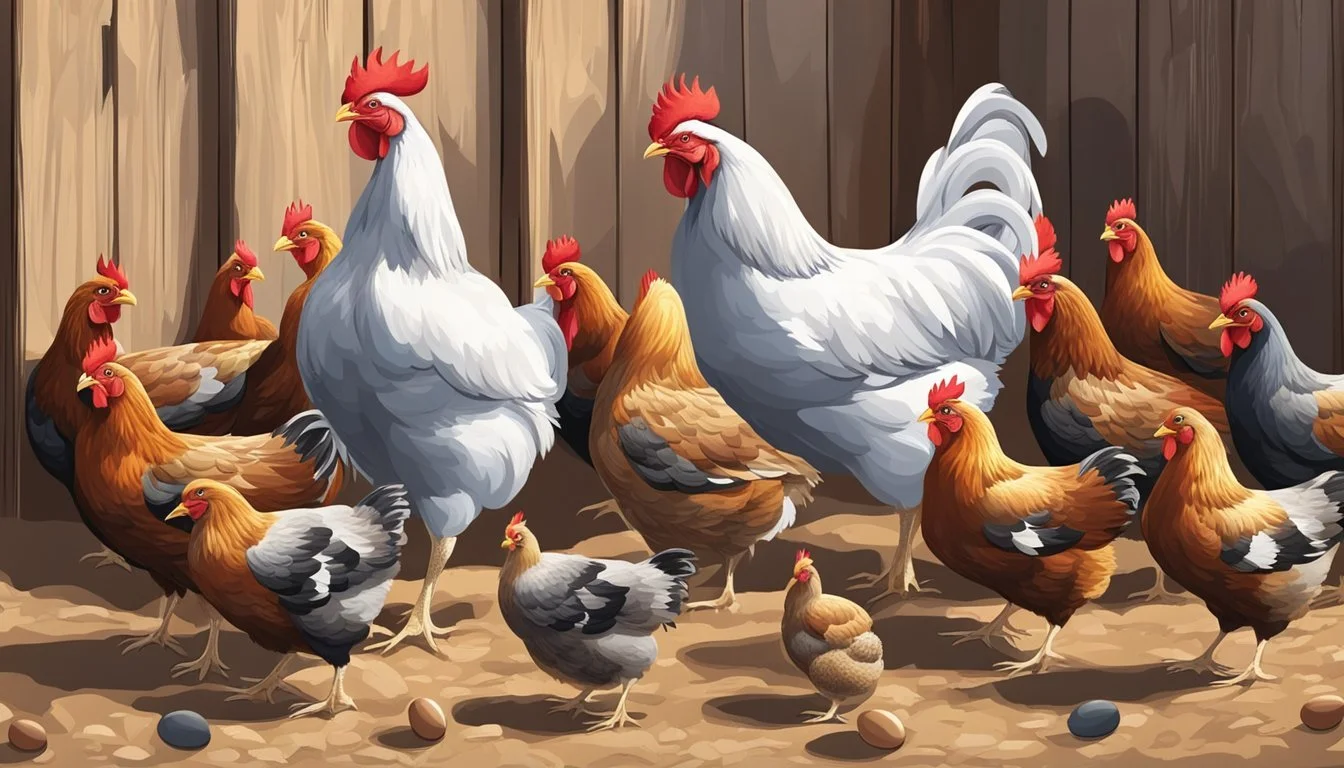How Do I Deal with Broody Hens?
Tips for Managing Nesting Behavior
Dealing with a broody hen can be a perplexing challenge for chicken owners. A hen becomes broody when she decides to sit on her eggs, or even on an empty nest, with the intention of hatching chicks. This behavior is natural, but it can become an issue if the hen is not part of a breeding program or if she becomes overly aggressive or neglects her own well-being. Broody hens may refuse to leave their nest for extended periods, foregoing the need to eat, drink, or interact with the rest of the flock.
Recognizing broody behavior is key to managing it effectively. Common signs include a hen spending most of her time in the nest, possibly pulling out her feathers to create a warm environment for her eggs, and showing aggression when approached. It is essential to address this behavior promptly to maintain the health of the hen and the harmony within the flock.
There are various strategies to discourage broodiness in hens, ranging from repeatedly removing them from the nest to altering their nest environment. Chicken owners must undertake these methods with care and persistence to successfully deter a hen from her persistent desire to hatch eggs. Balancing firmness with the well-being of the hen is crucial to ensure she integrates back into the flock and resumes her regular chicken activities.
Understanding Broodiness
Dealing with broody hens involves recognizing their natural inclinations to hatch and raise chicks. A hen's hormones, breed, and personality significantly influence these behaviors.
What Is Broodiness?
Broodiness refers to a hen's instinct to sit on a clutch of eggs with the intention to hatch them. This behavior is driven by hormonal changes that trigger an overwhelming desire to incubate eggs and, later on, rear the chicks. The broody hen will persistently sit on the eggs, occasionally leaving to eat, drink, or relieve herself.
Signs of Broodiness
Recognizing the signs of broodiness is critical for timely and effective intervention. Common indicators include:
A hen spending more time in the nest, even without eggs
Feathers plucked to line the nest, creating a warm environment
A reluctance to move or growling and pecking when disturbed
Flattened body posture to cover the eggs thoroughly
Broodiness Across Breeds
Certain chicken breeds are more prone to broodiness due to their genetic predisposition. For example, Silkies and Cochins are known for being excellent mothers and are often quite broody, while Leghorns and other production breeds are less likely to exhibit this behavior. Understanding the tendencies of your hen's breed can help in managing and responding to broodiness effectively.
Managing a Broody Hen
When managing a broody hen, it's essential to consider her nutrition and comfort. Adjusting her environment and ensuring her basic needs are met can impact her brooding behavior.
Feeding and Watering Necessities
A broody hen requires consistent access to food and water, as she may neglect her own needs to stay on the nest. One should:
Ensure the availability of a balanced diet; offer layer feed rich in calcium and proteins to support egg production.
Position food and water where it's easily accessible to encourage the broody hen to eat and drink without straying far from the eggs.
Nesting Box Adjustments
The nesting box environment can influence a hen's broodiness. Modifications might be needed to either support or discourage this natural behavior:
To support broodiness: make the nesting box comfortable, with ample bedding to insulate and protect the eggs.
To discourage broodiness: for hens you don't want to hatch eggs, make frequent changes to the nesting area to disrupt the setting, using techniques such as removing eggs from the nest or altering the comfort of the box.
Breaking the Broodiness
Dealing with a broody hen requires understanding the right time to intervene and knowing which humane techniques can safely break her cycle of broodiness.
When to Break Broodiness
A hen becomes broody when she decides to sit on her eggs to hatch them; however, not all broody periods are desirable. One should consider breaking a broody hen if she does not have a clutch of fertilized eggs to hatch or if her health is at risk from prolonged sitting, which includes loss of weight and neglect of her own well-being. Prolactin, the hormone responsible for broodiness, often causes hens to be stubborn, making intervention necessary.
Techniques for Breaking Broodiness
Removal from the Nest Box: Consistently removing the broody hen from the nest box and preventing reentry can help disrupt the cycle.
Changing the Environment: Increased sunlight and activity can lower a hen's body temperature and reduce prolactin levels.
Cooling the Hen: Cooling the underside of the hen through methods like placing her on a wire-bottomed cage or offering frozen water bottles can discourage broodiness by dropping the body temperature.
It's essential to monitor a hen's condition throughout the process to ensure her health and well-being remain a priority.
Hatching and Raising Chicks
When dealing with broody hens, two critical aspects to manage are the incubation of fertile eggs and the subsequent care for the hatchlings. Providing the right environment and care during these stages ensures the successful hatching and raising of chicks.
Incubating Fertile Eggs
A broody hen will instinctively incubate fertile eggs by maintaining the necessary warmth and humidity. She typically does this by adjusting her position periodically to ensure even warmth distribution. Hens also turn the eggs, which is critical for proper embryo development. For those who do not have a broody hen or prefer a more controlled environment, using an incubator is an alternative. It is important to keep the incubator at a steady temperature of 99.5°F and a humidity level of around 50% to 55%, increasing to 65% to 75% several days before the expected hatch date.
Caring for the Hatchlings
Once the eggs have hatched, the chicks require attentive care. A mother hen will usually take charge, teaching the hatchlings to eat, drink, and stay warm. If raising chicks without a hen, the caretaker must provide a brooder with a heat source to keep the chicks at an appropriate temperature of 95°F for the first week and reduce it by 5°F each week thereafter. It is essential that chicks have access to clean water and a starter feed that is high in protein to support their rapid growth. Observing the chicks for any signs of distress or illness is crucial in the early stages of their development.
Health and Safety Considerations
When addressing broody hen behavior, it's essential to consider both the health of the hen and the safety of the eggs. Predators can pose a significant threat and poor nest hygiene can lead to parasitic infestations, affecting the hen’s wellbeing.
Predator Protection
Broody hens tend to be less aware of their surroundings, which can leave them vulnerable to predators. To ensure her safety, as well as the eggs' or chicks', the nesting area needs to be secured. Using hardware cloth can prevent access from most predatory animals. Additionally, one should regularly inspect the coop for potential weak spots where a predator could enter.
Managing Parasites and Nest Hygiene
The nesting material within the nesting area requires regular inspection and replacement to prevent dust buildup and parasite infestation. Dirty or damp bedding is an ideal breeding ground for mites and lice. Cleaning the nest regularly, providing fresh material, and treating the hen for parasites as needed will promote healthy brooding behavior.
Seasonal and Breed-Specific Challenges
Dealing with broody hens requires an understanding of their breed-specific tendencies and the seasonal influences that can affect their behavior. Certain breeds are more inclined to broodiness, and environmental factors such as daylight and temperature can prompt or deter this natural instinct.
Timing and Frequency in Various Breeds
Broodiness varies significantly across different chicken breeds. Silkies and Cochins, for example, are more prone to broodiness, often going broody several times a year. On the other hand, hybrid chicken breeds like the Golden Comet are selectively bred for egg production and tend to be less broody. This behavior can occur in any season but is most common in the spring and early summer when the conditions are ideal for raising chicks.
Silkies: High frequency of broodiness, regardless of season
Cochins: Known for being exceptionally broody throughout the year
Hybrid Breeds: Typically less broody, focused on egg-laying
Environmental Factors Affecting Broodiness
Daylight and temperatures play crucial roles in influencing a hen's broodiness. Longer daylight hours in spring and summer can trigger the brooding behavior as it aligns with the optimal time for chick survival. Warmer temperatures also support this, although extreme heat can disrupt the hen's comfort and deter broodiness.
Daylight: Longer days can increase the likelihood of broodiness.
Temperatures: Moderate warmth is conducive to broodiness, but high temperatures can be discouraging.
Understanding these factors helps poultry keepers manage and respond to broody behavior in their flocks effectively.
Alternative Uses for Broody Hens
Broody hens can be more than just a challenge for poultry keepers; they offer unique opportunities to utilize their natural instincts beneficially. Their strong desire to sit on eggs and their capability of incubation can be harnessed for purposes beyond chicken rearing.
Fostering Eggs from Other Birds
A broody hen can be an excellent foster mother, not only to chicken eggs but also to those of other bird species. They often readily accept duck, turkey, guinea, and even goose eggs. One must ensure the broody hen has a secluded and comfortable nest to accommodate the size and number of the foster eggs, and they typically need 2-4 additional weeks for incubation compared to chicken eggs.
Broody Hens in Natural Pest Control
During their brooding period, hens tend to move less and spend more time in the nest, but they can still play a role in pest control. When taking breaks from the nest, they may hunt for insects, grubs, and ticks in the surrounding area. This natural behavior can assist in reducing pests in the garden or farm. A healthy balance between resting in the nest and foraging can be maintained to leverage their pest control ability without interrupting the incubation process.
Social Dynamics and Flock Management
Managing a flock involves understanding the behavior of broody hens and their integration back into the flock, as well as addressing challenges related to aggression and territorial behaviors.
Integrating Broody Hens into the Flock
A broody hen, characterized by behaviors such as puffing up, growling, noisy clucking, and occasionally biting, may require special attention when reintegrating with the flock. Post-broodiness, it's important to ensure a smooth re-entry for the hen, as flock dynamics can be disrupted. Monitoring the interactions of broody hens with the rest of the flock is crucial since their inclination to stay in the nesting area and protect their eggs can lead to tension. To facilitate integration, one should provide a separate space where the broody hen can readjust while still seeing and hearing the flock. Read more about reintegrating broody hens.
Handling Aggression and Territorial Issues
Aggression in chickens can manifest when a broody hen defends her nest or when reintegrating into the flock. To prevent and handle these territorial issues effectively, it's important to observe the flock's hierarchy and spot signs of aggression early. Strategies might include removing eggs promptly to discourage broodiness or providing multiple feeding stations to minimize competition. When aggression occurs, separate the aggressive hen temporarily and reintroduce her later, ensuring she has adequate space to avoid encroaching on other hens' territory. More on managing the behaviors of moody chickens can be found here.



